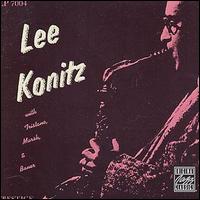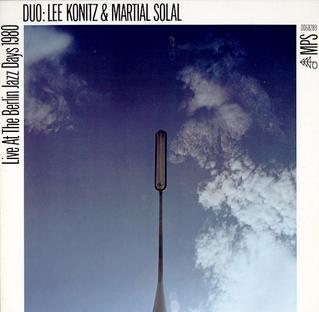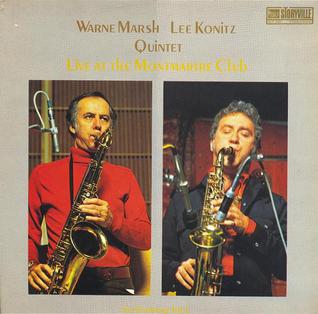Related Research Articles
Free improvisation or free music is improvised music without any rules beyond the logic or inclination of the musician(s) involved. The term can refer to both a technique and as a recognizable genre in its own right.
Cool jazz is a style of modern jazz music that arose in the United States after World War II. It is characterized by relaxed tempos and lighter tone, in contrast to the fast and complex bebop style. Cool jazz often employs formal arrangements and incorporates elements of classical music. Broadly, the genre refers to a number of post-war jazz styles employing a more subdued approach than that found in other contemporaneous jazz idioms. As Paul Tanner, Maurice Gerow, and David Megill suggest, "the tonal sonorities of these conservative players could be compared to pastel colors, while the solos of [Dizzy] Gillespie and his followers could be compared to fiery red colors."

Leon Konitz was an American composer and alto saxophonist.

Leonard Joseph Tristano was an American jazz pianist, composer, arranger, and teacher of jazz improvisation.

Warne Marion Marsh was an American tenor saxophonist. Born in Los Angeles, his playing first came to prominence in the 1950s as a protégé of pianist Lennie Tristano and earned attention in the 1970s as a member of Supersax.

Billy Bauer was an American jazz guitarist.

Subconscious-Lee is a jazz album by Lee Konitz although a few tracks were issued on 78rpm under Lennie Tristano's name. It was recorded in 1949 and 1950, and released on the Prestige label.

Denzil DaCosta Best was an American jazz percussionist and composer born in New York City. He was a prominent bebop drummer in the 1950s and early 1960s.
Ronald "Ronnie" Ball was a jazz pianist, composer and arranger, born in Birmingham, England.
Peter Ind is a British jazz double bassist and record producer.

Lennie Tristano, also known as Tristano, is a 1956 album by jazz pianist Lennie Tristano. At its release, the album was controversial for its innovative use of technology, with Tristano overdubbing piano and manipulating tape speed for effect on the first four tracks. The final five songs are concert recordings. Originally released as Tristano's Atlantic Records debut, the album was released on CD in 1994 by Rhino Records in combined form with Tristano's 1960 follow-up, The New Tristano, and as part of a collection, The Complete Atlantic Recordings of Lennie Tristano, Lee Konitz & Warne Marsh, in 1997. It was subsequently re-issued in original form and track-list order by Warner Jazz (2002), Rhino (2003) and Collectables (2004).
Theodore (Ted) G. Brown, born December 1, 1927 in Rochester, New York, is a cool jazz tenor saxophonist.

The New Tristano is an album by jazz pianist Lennie Tristano. It was recorded in 1961 and was released by Atlantic Records in February 1962.
Crosscurrents is an album by jazz pianist Lennie Tristano. It was recorded in 1949 and released by Capitol in 1972. The album was inducted into the Grammy Hall of Fame in 2013.

The Lee Konitz Quintet is an album by American jazz saxophonist Lee Konitz recorded in 1977 and released on the Chiaroscuro label.

Live at the Berlin Jazz Days 1980 is a live album featuring a memorial concert for Lennie Tristano by saxophonist Lee Konitz and pianist Martial Solal which was recorded at the Berliner Philharmonie by Sender Freies Berlin as part of the Berliner Jazztage in 1980 and released on the MPS label in 1982. The album was also released in the US on Pausa Records.

Warne Marsh Quintet: Jazz Exchange Vol. 1, is a live album by saxophonist Warne Marsh's Quintet featuring Lee Konitz and Niels-Henning Ørsted Pedersen which was recorded at the Jazzhus Montmartre in late 1975 and released on the Dutch Storyville label.

Warne Marsh Quintet: Jazz Exchange Vol. 2, is a live album by saxophonists Warne Marsh and Lee Konitz which was recorded at the Jazzhus Montmartre in late 1975 and released on the Dutch Storyville label.

Warne Marsh Lee Konitz: Jazz Exchange Vol. 3, is a live album by saxophonists Warne Marsh and Lee Konitz which was recorded at the Jazzhus Montmartre in late 1975 and released on the Dutch Storyville label in 1985.

This is the discography for American jazz musician Lee Konitz.
References
- ↑ Palmer, Robert (January 24, 1982). "Lennie Tristano – A Neglected Jazzman". The New York Times.
- 1 2 3 4 5 Shim 2007, p. 50.
- 1 2 Shim 2007, p. 51.
- ↑ Shim 2007, pp. 48–51.
- ↑ Harrison, Max (1991). A Jazz Retrospect . Quartet. p. 70. ISBN 0-7043-0144-X.
- 1 2 3 4 Shim 2007, p. 179.
- 1 2 Shim 2007, pp. 179–180.
- ↑ Shim 2007, p. 180.
- 1 2 3 4 Shim 2007, p. 52.
- ↑ Shim 2007, p. 53.
- ↑ Shim 2007, pp. 53–54.
- ↑ Shim 2007, pp. 56–58.
- ↑ Yanow, Scott. "Lennie Tristano: Crosscurrents". AllMusic. Retrieved September 1, 2020.
- 1 2 Kelsey, Chris. "Artist Biography". AllMusic. Retrieved September 26, 2014.
- Bibliography
- Shim, Eunmi (2007). Lennie Tristano – His Life in Music. University of Michigan Press. ISBN 978-0-472-11346-0.CS1 maint: ref=harv (link)